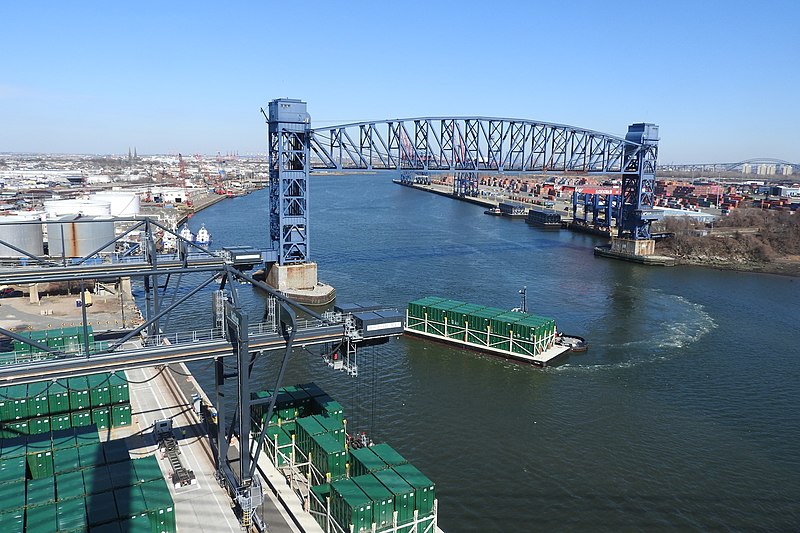Movable bridge
|
The Arthur Kill bridge in Staten Island, New York, is a vertical lift bridge used to transport rubbish and freight via rail. Its lift span is one of the longest in the world. |
Contents |
[edit] Introduction
A bridge is a spanning structure that creates a passage over an obstacle such as a river, gorge, valley, road, railway and so on. A movable bridge (or moveable bridge) is a spanning structure that can change position (or even shape) to accommodate different situations, such as the requirements of ships, barges and other types of traffic above or below it. However, they can be inconvenient due to delays caused when one stream of traffic is halted to accommodate the passage of the other.
[edit] Operations
Movable bridges are typically operated by counterweights (including auxiliary counterweights), or other mechanical systems (such as electric or hydraulic drives). Modern movable bridges may be controlled by stabilising machinery, span brakes and other mechanisms.
[edit] Drawbridges
There is evidence that movable bridges were first used in ancient times, but it wasn’t until the Middle Ages that they appeared in Europe. During this period, the drawbridge (also referred to as a bascule or lifting bridge) was sometimes incorporated into defensive mechanisms used to protect a castle, village or town. These early drawbridges did not typically include counterweights.
The drawbridge is the most common type of movable bridge. It is also the term that is typically used for all movable bridges in the US. This is not the case in the UK, where the term is more frequently used to describe the defensive version of a drawbridge that is associated with medieval structures.
The bascule bridge is one type of drawbridge. Depending on the number of platforms, they are referred to as single-, double-, triple- or quadruple leaf bascule bridges.
There are several other types of drawbridges, including:
[edit] Other movable bridges
Engineering advances during the 1800s made it possible to incorporate new technologies and materials into the construction of movable bridges. This resulted in the introduction of several new types of movable bridges, including:
- Pontoon.
- Retractable (including thrust, floating retractable and Guthrie rolling versions)
- Submersible (also referred to as a ducking or low water bridge, although many low water bridges are not movable).
- Swing (or pivot).
- Table.
- Tilt.
- Transporter (also known as a ferry or aerial transfer bridge)
- Vertical-lift.
[edit] Related articles on Designing Buildings
IHBC NewsBlog
Old Sarum fire in listed (& disputed) WW1 Hangar - Wiltshire Council has sought legal advice after fire engulfed a listed First World War hangar that was embroiled in a lengthy planning dispute.
UK Antarctic Heritage Trust launches ‘Virtual Visit’ website area
The Trust calls on people to 'Immerse yourself in our heritage – Making Antarctica Accessible'
Southend Council pledge to force Kursaal owners to maintain building
The Council has pledged to use ‘every tool in the toolbox’ if urgent repairs are not carried out.
HE’s Research Magazine publishes a major study of the heritage of England’s suburbs
The article traces the long evolution of an internal programme to research 200 years of suburban growth
IHBC Context 183 Wellbeing and Heritage published
The issue explores issues at the intersection of heritage and wellbeing.
SAVE celebrates 50 years of campaigning 1975-2025
SAVE Britain’s Heritage has announced events across the country to celebrate bringing new life to remarkable buildings.
IHBC Annual School 2025 - Shrewsbury 12-14 June
Themed Heritage in Context – Value: Plan: Change, join in-person or online.
200th Anniversary Celebration of the Modern Railway Planned
The Stockton & Darlington Railway opened on September 27, 1825.
Competence Framework Launched for Sustainability in the Built Environment
The Construction Industry Council (CIC) and the Edge have jointly published the framework.
Historic England Launches Wellbeing Strategy for Heritage
Whether through visiting, volunteering, learning or creative practice, engaging with heritage can strengthen confidence, resilience, hope and social connections.















